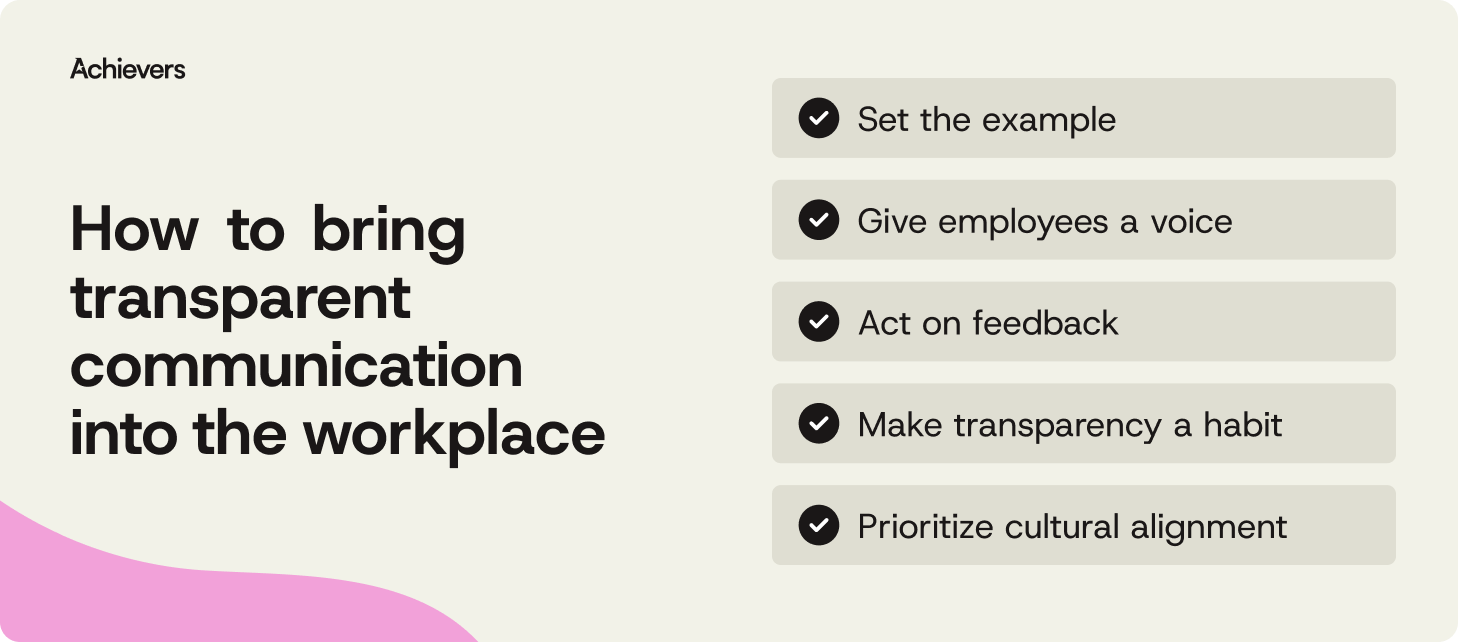Table of contents
Create a culture that means business™
Schedule a demo with an Achievers solution expert today.
Transparent communication sounds simple enough — be open, be honest, and keep people in the loop. But in practice? It’s often anything but.
Real transparency isn’t just answering questions when they come up. It’s the difference between “We’re all in this together” and actually meaning it.
And while it might not fix every workplace challenge overnight, transparent communication has a ripple effect. It encourages trust and collaboration at work, and keeps people engaged even when the news isn’t all sunshine and smiles.
The good news? Transparency doesn’t have to be aspirational. Let’s dig into what that looks like, and how to bring it to life in the workplace.
5 ways to make transparent communication part of the workplace
Transparent communication isn’t a single moment. It’s a muscle you build. And like any muscle, it needs training, support, and a few solid reps before it becomes second nature.
These five strategies are how leading organizations make transparency stick, from the boardroom to the breakroom:

1. HR and leadership must set the example
Transparency starts at the top — but it can’t stop there. When leaders model open, proactive communication, it signals to everyone that honesty isn’t just encouraged, it’s expected. That kind of visibility builds psychological safety and sets the tone for how the entire organization communicates.
What this looks like:
- Share updates early and often, even when decisions are still in progress.
- Host regular all-hands or team meetings to discuss goals, challenges, and performance openly.
- Acknowledge mistakes and explain tough decisions to build trust, not spin.
- Recognize transparency in action — especially from managers — to reinforce the behavior you want to see more of.
2. Give employees a real voice
Think of transparency as a conversation. Employees need to feel like their voice matters, not just during engagement surveys, but every day. That means creating safe, reliable channels for input and actively listening to what’s said.
What this looks like:
- Use employee feedback tools to collect real-time insights through pulse surveys, open forums, and anonymous comments.
- Normalize feedback loops with Q&A segments during meetings or leadership AMAs.
- Ask for feedback during key decisions, not just after.
- Be clear about how feedback is used and follow up, so employees know their voice drives action.
3. Act on employee feedback
Asking for input without follow-through is worse than silence. It sends the message that honesty won’t lead anywhere. To build a culture of transparency, you need to close the loop and show employees their feedback matters.
What this looks like:
- After surveys or feedback sessions, share what was heard and what’s being done about it.
- Co-create action plans with teams — giving them ownership of the outcomes.
- Track and report on progress to reinforce accountability.
- Celebrate wins that stem directly from employee input.
4. Make transparency a habit
Anyone can be transparent when things are going well. The real test is how you communicate in the messy moments — the missed targets, the tough calls, the stuff that’s harder to say out loud. When transparency only shows up during a crisis or a company-wide campaign, people notice. And not in a good way.
What this looks like:
- Share performance data regularly, not just at review time.
- Include clear roles and responsibilities during project kickoffs so everyone starts on the same page.
- Use daily or weekly huddles to update on goals, priorities, and blockers.
- Equip managers with scripts, training, or nudges to help make transparent communication second nature.
5. Prioritize cultural alignment
Transparency thrives in cultures where people feel respected, included, and aligned around shared values. When those core values aren’t just printed on posters — they’re practiced in how people communicate, collaborate, and show up for each other every day.
What this looks like:
- Use a recognition platform to highlight behaviors that reflect your values — like openness, collaboration, and candor.
- Train leaders to share openly while respecting different perspectives — especially in diverse, global teams.
- Hire for values alignment, then reinforce those values in how you communicate.
- Recognize teams that raise issues early and ask the hard questions respectfully.
The benefits of transparency at work
Transparency isn’t just good ethics — it’s good business. When people know what’s going on, why it’s happening, and how they can contribute, everything runs smoother. Trust deepens, silos crack open, and teams work with clarity instead of second-guessing. Here’s what that looks like in action:
- Increased trust: When people know what’s really going on — not just the polished version — it builds lasting trust. And when it’s met with frequent recognition, data from the State of Recognition Report tells us that employees are 19x more likely to trust their managers. It all helps people believe that leaders have nothing to hide (because they don’t).
- Improved retention: Employees who feel informed, included, and respected are far less likely to walk out the door. Transparency signals that you trust your people — and that trust tends to be mutual, especially when it’s met with clear action.
- More engaged employees: No one’s inspired by vague updates and mixed signals. Clear, open communication gives people a reason to care and helps them see how their work connects to something bigger.
- Better culture: Transparent communication cuts through confusion, breaks down silos, and makes collaboration safer and more inclusive. When everyone’s working from the same facts, there’s less room for gossip, guessing, or passive-aggressive reply-alls.
- A strong employer brand: Candidates and customers pay attention to how you treat your people. When communication is clear and consistent, it builds a reputation rooted in trust, and that’s what attracts top talent and makes them want to stick around.
- Stronger connections: Open communication builds stronger relationships across roles and teams. When people feel safe to be honest — and see that honesty returned — collaboration becomes easier, feedback gets more real, and trust grows deeper.
- Fewer conflicts: Many conflicts come from crossed wires, not clashing values. Transparency keeps expectations clear, reduces misunderstandings, and ensures fewer “Why didn’t anyone tell me?” moments. Everyone stays on the same page — and in fewer heated meetings.
- Greater innovation: When transparency is part of the culture, employees feel more comfortable speaking up — even if their idea isn’t fully polished. That openness fuels creativity, sparks problem-solving, and helps great ideas come from unexpected places.
- Smarter decision-making: Clear, shared information leads to better decisions. When everyone — not just leadership — has context, teams can move faster, spot issues sooner, and align on solutions that actually work.
What does transparent communication in the workplace look like?
Transparency doesn’t mean flooding inboxes with updates or holding endless town halls. It means being real, being clear, and being consistent — even when it’s uncomfortable.
Here’s what that looks like in practice:
- Honest and open dialogue: Transparency starts with sharing the full picture — not just the parts that are easy to say out loud. It means communicating decisions, updates, and challenges without spin, and building trust by telling the truth (even when the news isn’t great).
- Clear & concise updates: Honest communication still needs to be digestible. That means ditching the jargon, avoiding corporate fog, and giving people the right amount of context to actually understand what’s going on — quickly and clearly.
- Accessible information: Transparency doesn’t work if the message only reaches a select few. Make information easy to find and easy to access, no matter where employees sit in the company or what kind of work they do.
- Two-way discussions: True transparency is a conversation, not a broadcast. That means inviting questions, encouraging feedback, and creating safe spaces where employees can challenge, clarify, or contribute without fear.
- Accountability and ownership: Being transparent isn’t just about what you say — it’s also about what you own. When managers admit mistakes, explain their decisions, and invite feedback, they model the kind of accountability that builds lasting trust.
Support transparent communication with tools built for trust
Building a transparent culture takes more than good intentions — it takes tools that make honest communication part of how work gets done. That’s what we’re built for.
From our Voice of Employee listening tools to a central employee communications hub, our platform helps you embed transparency into how your organization runs every day.
Here’s how it works:
- Gather honest input with pulse surveys, polls, and quizzes that track feelings and opinions in real time.
- Close the loop fast using customizable templates, post-event feedback, and self-serve reporting.
- Keep employees informed with scheduled announcements, mobile notifications, and centralized resource hubs.
- Reach everyone — desk or deskless workers, global or local — with multilingual, mobile-friendly access.
When feedback and communication tools work together, people stop wondering what’s going on and start feeling like part of the conversation.
Make transparent communication a culture-must
If there’s one thing we know, it’s this: transparency isn’t just about saying the right thing — it’s about doing it consistently. That means sharing early, listening often, and walking the walk. When that becomes part of how your company works, trust builds, engagement grows, and people stop guessing and start contributing.
That’s the kind of culture Achievers helps create — where feedback flows, communication is clear, and recognition reinforces the behaviors that move your business forward.
We help make transparent communication how things work — not just what you say.



